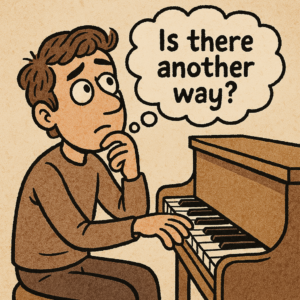 It’s fascinating how the lessons we learn early on can quietly become unquestioned truths—especially when they come from someone we admire. Their method becomes the method, and slowly, our understanding gets encased in routine. It feels secure. Familiar. Even sacred. Until something shakes that foundation.
It’s fascinating how the lessons we learn early on can quietly become unquestioned truths—especially when they come from someone we admire. Their method becomes the method, and slowly, our understanding gets encased in routine. It feels secure. Familiar. Even sacred. Until something shakes that foundation.
For me, that “stone” was how I understood chords on the piano. Triads had three positions. Seventh chords had four. End of story. I practiced them. I used them. I taught them. But somewhere along the way, I stumbled into the concept of chord voicings—and everything changed. The possibilities didn’t just expand; they exploded. Suddenly, what had felt like rigid architecture became fluid artistry. My playing became more nuanced, more expressive… more me.
The real shift wasn’t in technique alone—it was in mindset. I had unknowingly placed boundaries around my creativity, and voicings gave me permission to redraw them. It’s a reminder that musical growth isn’t just about gaining new skills—it’s about shedding old limits.
✨ Here’s something worth trying:
🧠 The next time you sit at the piano, take a moment. Pause before playing. Let the silence invite curiosity. Ask yourself: “Is there another way?” That simple question could be your key to transformation. You might discover a new texture, a fresh emotional color, or a voicing that resonates more deeply than anything you’ve played before.
Because what we play is only part of the story.
How we think about playing—how willing we are to challenge our habits—is where real growth lives. That’s the heart of artistic evolution. And that’s something worth celebrating.
So let your time at the piano be more than practice. Let it be discovery. Let it be freedom. Let it be a reflection of your voice, evolving one question at a time.
